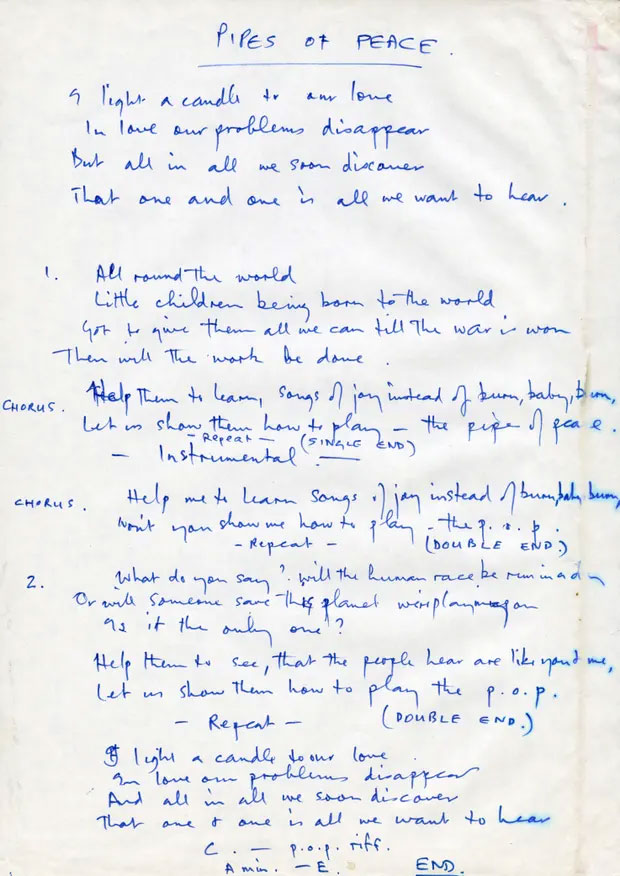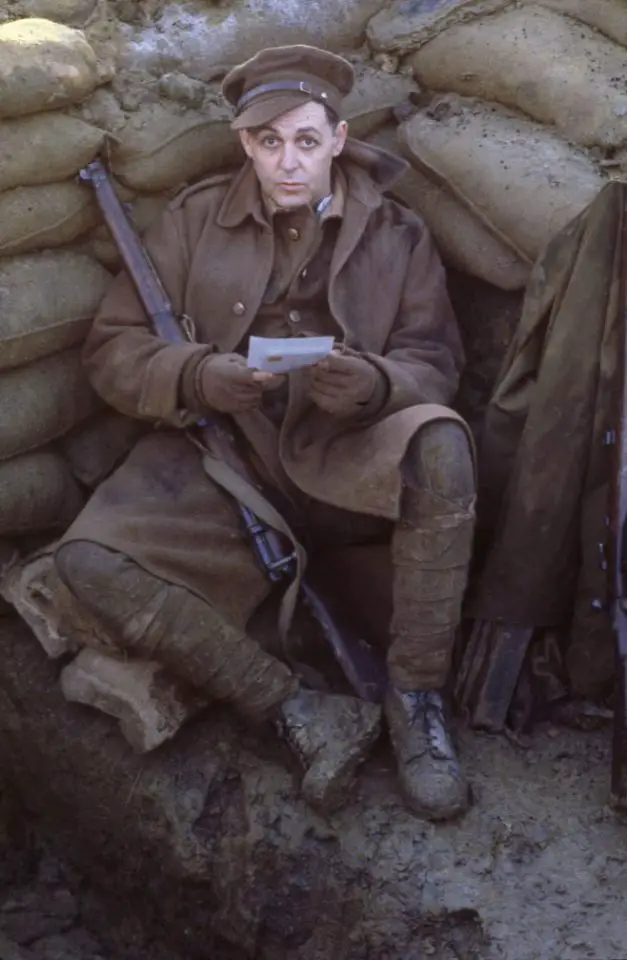‘Pipes Of Peace’ was the second single and title track from Paul McCartney’s fourth solo studio album Pipes Of Peace.
The song was written following a request from a friend, jazz musician George Melly, and was initially intended as a charity release.
George Melly wrote to me and said, ‘There’s this children’s organisation and they want a peaceful song for children, a hopeful song for the future. Would you be interested in doing it?’ So I set about trying to do it – then it became a song for me. If you can do an anti-war song that doesn’t feel too cloying, then it’s really good if you’re an anti-war person, as I am. You feel you’ve done something worthwhile.
Club Sandwich, Spring 1988
Inspiration came from two other key sources: the poem ‘Light A Candle’ by Rabindranath Tagore, and the August 1965 riots in Watts, Los Angeles.
Around the time ‘Pipes Of Peace’ was being written at the beginning of the eighties, I was in another favourite bookshop, Daunt Books on Marylebone High Street, and I found a book by the Bengali poet Rabindranath Tagore, who won a Nobel Prize. One of Tagore’s poems had a line ‘light a candle’ or something similar, and I just moved it around a bit. That was the start of this song. Tagore, with his sunken eyes and long, flowing beard, looks interesting in photographs, so that might’ve attracted me to him, but I really liked his poetry, so I nicked this one line.I might’ve misremembered the line. It might’ve just been the idea of lighting a candle to love, but that was what I remembered. It’s what we all long to hear: getting together, love for one another, ‘Little children being/Born to the world’, giving all we can till the war – the war that is life, as well as the war, wherever it may be today, that is maiming our planet – is won.
‘Songs of joy instead of/Burn baby burn’ was a phrase that became famous after the disturbances in Watts that destroyed much of downtown Los Angeles. So this song, written years later, became a sort of anthem for peace, which was very heartening. Heartening, too, that it was number one in the UK in December 1983.
The Lyrics: 1956 To The Present
In the studio
The backing track of ‘Pipes Of Peace’ was recorded in London’s AIR Studios on 10 September 1982.
George Martin produced the song, and McCartney performed the majority of instruments.
The track features a Linndrum drum machine, a casaba and kalimba, plus tabla performed by James Kippen and a pan flute part by Adrian Brett.
The track was incomplete. There was only the click track, Paul’s piano and vocals. Paul, George and Geoff [Emerick] had a good idea about what they wanted, but I didn’t! Paul gave me some idea of what he wanted for the first pattern. He used his hands on my drums to tap out a kind of rhythmic feel, and he was also speaking simple syllables in imitation of the drum syllables used by table players. I tried a few things and he seemed to like one particular pattern I played for him. It was that pattern, and variations or permutations of it, that I played over many takes. I tried something like 20-30 takes. The number of takes was dictated by George. What I played was similar each time, but not exactly the same. I was cued, I played, then stopped and waited for further instructions.There was a second session that I had to play too. Paul wanted some kind of fast drum roll. I showed him several. The one he liked was a cross-rhythmic pattern that grouped the strokes into 3+3+3+3+2+2, repeated
Paul McCartney: Music Is Ideas (1970-1989), Luca Perasi
The track also featured the Pestalozzi Children’s Choir. In 1981 they issued an album, Songs Of Joy, the title of which was referenced in the chorus of McCartney’s song:
Help them to learn
Songs of joy instead of burn baby burn
Let us show them how to play
The pipes of peace
Play the pipes of peace
Also singing backing vocals were Linda McCartney, Eric Stewart, and the young Stella and Mary McCartney.
The release
‘Pipes Of Peace’ was initially released as track one on the album of the same name, on 31 October 1983.
On 5 December 1983 it was released in the UK as the second single from the album, following the Michael Jackson duet ‘Say Say Say’.
The single, with ‘So Bad’ on the b-side, topped the charts for two weeks from 8 January 1984. It remains McCartney’s only solo UK number one single.
In the USA the two sides were flipped, so ‘Pipes Of Peace’ was on the b-side. ‘So Bad’ peaked at number 23 on the Billboard Hot 100.
The video
The video for ‘Pipes Of Peace’ depicted the Christmas truce of 1914, when a series of unofficial temporary ceasefires took place along the Western Front in World War One.
The promo was shot on Chobham Common in Surrey. It was directed by Keith McMillan and produced by Hugh Symonds, and featured over 100 extras.
It was also great fun making the video for this song. It was directed by a guy called Keith McMillan, with whom I’d made some other things. He had worked for the BBC, then he’d left and gone freelance. He and I were talking about ‘Pipes Of Peace’, and I remembered a piece of film that was shown on the telly when I was a kid, about soldiers in the trenches greeting each other in No Man’s Land and having a game of football on Christmas Day 1914. That’s where we started visually, so in the video I play both a British and a German soldier.
The Lyrics: 1956 To The Present



